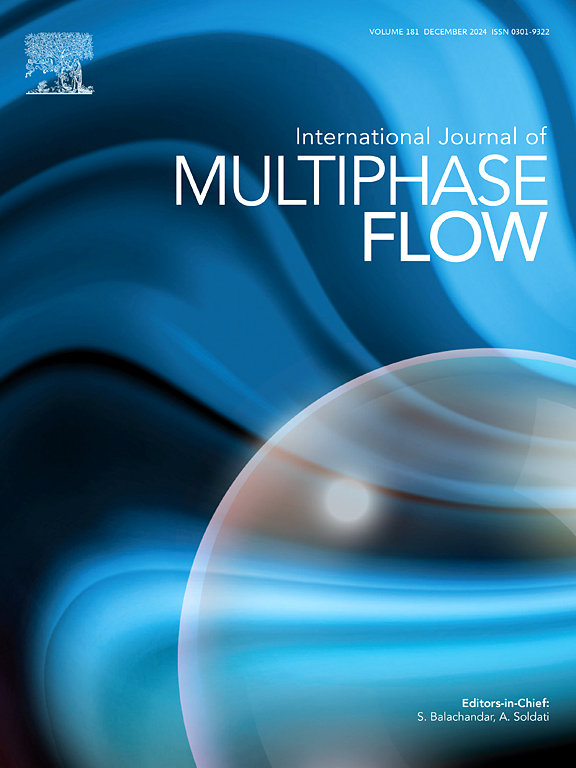Dynamic characteristics of thin vapor layers at substrate temperatures below the Leidenfrost point
IF 3.8
2区 工程技术
Q1 MECHANICS
International Journal of Multiphase Flow
Pub Date : 2025-06-28
DOI:10.1016/j.ijmultiphaseflow.2025.105332
引用次数: 0
Abstract
Volatile drops can levitate on hot substrates by forming a thin vapor layer beneath them. The minimum temperature for stable vapor layer formation is called the Leidenfrost point, but the transition mechanism remains unclear. To investigate this, we studied the liquid–solid contact of Leidenfrost drops below the Leidenfrost point. Steady-state, pancake-like water drops were generated by sandwiching water between a hot substrate and a glass capillary, forming nearly flat vapor films while maintaining constant volume. Vapor film shapes (with thicknesses on the order of , confirmed experimentally and by a heat conduction model) were observed by interferometry. Although the films were generally stable for several minutes, microscopic perturbations consistently appeared and stochastic, sudden liquid–solid contacts, likely induced by van der Waals interactions, occurred at a peak of the perturbations. The selection rules for the wavelength and amplitude of the perturbation (measured as 300–400 and 2 , respectively) were revealed by scaling analysis, derived from the balance between the vapor flow pressure drop and local Laplace pressure. Because the wavelength and amplitude were nearly insensitive to substrate temperature for a given drop radius, liquid–solid contact likely occurs when the vapor thickness approaches the perturbation amplitude. The liquid–solid contact is then driven by the natural resonance of the drops, which induces van der Waals interactions. Additionally, the effects of high (sapphire) and low (quartz) conductivity substrates were examined using an unsteady heat-conduction model, revealing that low-conductivity substrates exhibit larger local cooling, potentially promoting contact events.

衬底温度低于莱顿弗罗斯特点时薄气相层的动态特性
挥发性液滴可以通过在其下方形成薄蒸汽层而悬浮在热的基材上。稳定蒸汽层形成的最低温度被称为莱顿弗罗斯特点,但转变机制尚不清楚。为了研究这一点,我们研究了莱顿弗罗斯特点以下莱顿弗罗斯特液滴的液固接触。通过将水夹在热基板和玻璃毛细管之间,在保持恒定体积的情况下形成近乎平坦的蒸汽膜,可以产生稳态的煎饼状水滴。通过干涉测量法观察到气膜的形状(经实验和热传导模型证实,气膜厚度约为100 μm)。尽管薄膜在几分钟内通常是稳定的,微观扰动持续出现,随机的,突然的液固接触,可能是由范德华相互作用引起的,发生在扰动的峰值。根据蒸汽流压降和局部拉普拉斯压力的平衡,通过标度分析揭示了扰动波长和振幅的选择规律(测量范围分别为~ 300-400 μm和~ 2 μm)。由于波长和振幅对给定液滴半径的衬底温度几乎不敏感,当蒸气厚度接近摄动振幅时,可能发生液固接触。液固接触由液滴的自然共振驱动,从而引起范德华相互作用。此外,使用非稳态热传导模型研究了高(蓝宝石)和低(石英)导电性衬底的影响,发现低导电性衬底表现出更大的局部冷却,可能促进接触事件。
本文章由计算机程序翻译,如有差异,请以英文原文为准。
求助全文
约1分钟内获得全文
求助全文
来源期刊
CiteScore
7.30
自引率
10.50%
发文量
244
审稿时长
4 months
期刊介绍:
The International Journal of Multiphase Flow publishes analytical, numerical and experimental articles of lasting interest. The scope of the journal includes all aspects of mass, momentum and energy exchange phenomena among different phases such as occur in disperse flows, gas–liquid and liquid–liquid flows, flows in porous media, boiling, granular flows and others.
The journal publishes full papers, brief communications and conference announcements.

 求助内容:
求助内容: 应助结果提醒方式:
应助结果提醒方式:


